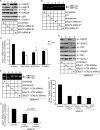A PDI family network acts distinctly and coordinately with ERp29 to facilitate polyomavirus infection
- PMID: 21159867
- PMCID: PMC3067762
- DOI: 10.1128/JVI.01855-10
A PDI family network acts distinctly and coordinately with ERp29 to facilitate polyomavirus infection
Abstract
Endoplasmic reticulum (ER)-to-cytosol membrane transport is a decisive infection step for the murine polyomavirus (Py). We previously determined that ERp29, a protein disulfide isomerase (PDI) member, extrudes the Py VP1 C-terminal arm to initiate ER membrane penetration. This reaction requires disruption of Py's disulfide bonds. Here, we found that the PDI family members ERp57, PDI, and ERp72 facilitate virus infection. However, while all three proteins disrupt Py's disulfide bonds in vitro, only ERp57 and PDI operate in concert with ERp29 to unfold the VP1 C-terminal arm. An alkylated Py cannot stimulate infection, implying a pivotal role of viral free cysteines during infection. Consistent with this, we found that although PDI and ERp72 reduce Py, ERp57 principally isomerizes the virus in vitro, a reaction that requires viral free cysteines. Our mutagenesis study subsequently identified VP1 C11 and C15 as important for infection, suggesting a role for these residues during isomerization. C11 and C15 also act together to stabilize interpentamer interactions for a subset of the virus pentamers, likely because some of these residues form interpentamer disulfide bonds. This study reveals how a PDI family functions coordinately and distinctly to promote Py infection and pinpoints a role of viral cysteines in this process.
Figures





References
-
- Appenzeller-Herzog, C., and L. Ellgaard. 2008. The human PDI family: versatility packed into a single fold. Biochim. Biophys. Acta 1783:535-548. - PubMed
Publication types
MeSH terms
Substances
Grants and funding
LinkOut - more resources
Full Text Sources
Miscellaneous

